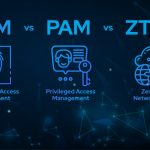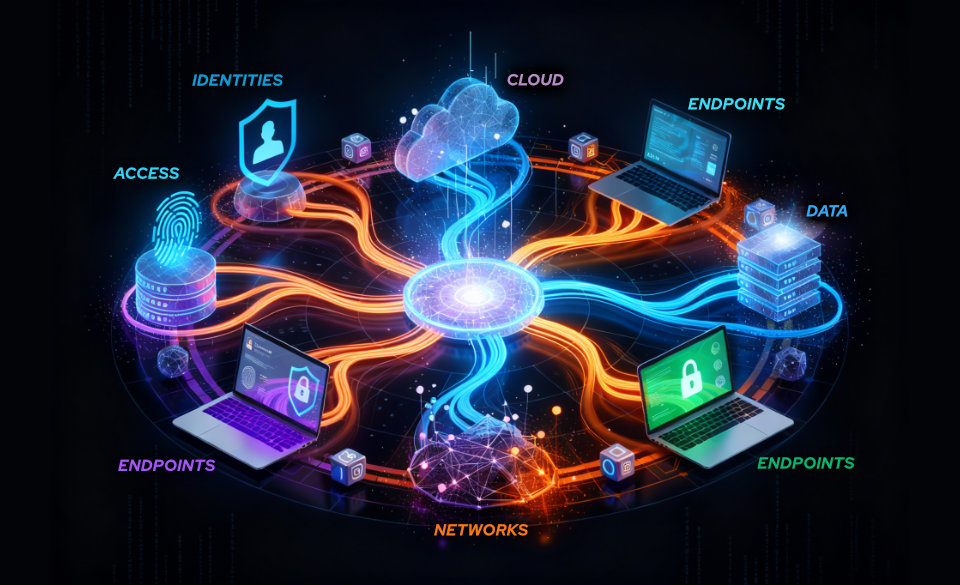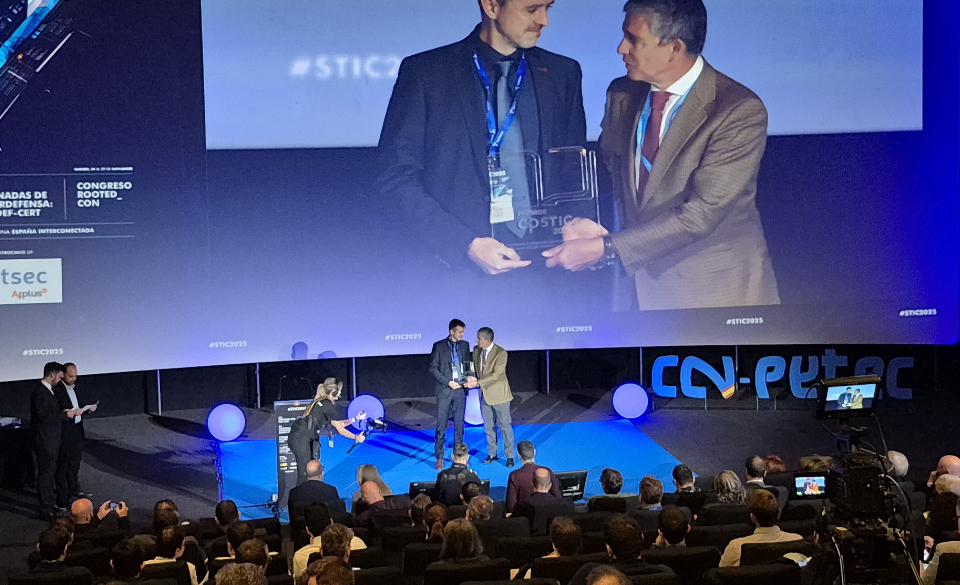
Cybersecurity in Photovoltaic Plants: Safeguarding the Future of Energy
3 de April de 2025
IAM, PAM, or ZTNA: What Solution Does Your Company Need?
17 de April de 2025What is ZTNA?
ZTNA (Zero Trust Network Access) is a modern cybersecurity model that responds to a paradigm shift: instead of trusting users and devices just because they are inside the corporate network, ZTNA assumes that all access is potentially insecure, even if it originates from the corporate environment itself. Therefore, the only way to ensure security is to continuously verify, authenticate, and authorize without exceptions.
This model allows organizations to offer secure, segmented access to their applications, data, and resources, based on criteria such as user identity, device status, connection context, and pre-defined policies. Unlike traditional approaches, ZTNA eliminates direct visibility of resources for any unauthenticated entity, dramatically reducing the attack surface.
How does ZTNA work?
1. Indirect Access and Resource Hiding
One of the main strengths of ZTNA is that corporate resources are never directly visible on the internet or to unauthenticated users. The system completely hides the infrastructure and applications, making them invisible to scans or search engines. This significantly reduces the likelihood of them being detected or attacked from outside the organization.
Access is only enabled once the entire context is verified, making ZTNA an ideal strategy to protect both internal applications and critical services that should never be exposed.
2. Strict and Contextual Authentication
Before any connection is established, ZTNA requires solid authentication that not only confirms who the user is but also under what conditions they are accessing. This includes verifying the user’s identity through corporate directories (like LDAP or Azure AD), checking if the device is managed by the company, whether its operating system is up to date, if it has an active security agent, and even if it is accessing from a permitted geolocation.
Additionally, access may vary depending on the context: accessing from a corporate laptop inside the office is different from accessing from a personal device in another country. These contextual policies allow security to adapt to real-time risk levels.
3. Micro-Segmentation
ZTNA is based on a micro-segmented network architecture, meaning users do not have access to the entire network as they would in classic models. Instead of opening access to an entire subnet, the user only connects to the specific application or resource they are permitted to access. This prevents lateral movement, which attackers often exploit once inside the network, and limits the impact of any potential intrusion.
Each resource can have its own set of rules and controls, strengthening security in a granular and flexible manner.
4. ZTNA Brokers
Access always goes through a control layer known as the ZTNA broker or gateway. This component acts as an intermediary between the user and the resource, handling all the pre-validation: checking credentials, verifying the device status, comparing policies, and establishing a secure connection only if everything is correct.
This broker can function as a reverse proxy, an encrypted SDP (Software-Defined Perimeter) tunnel, or through agents installed on the endpoint. Additionally, all access and events are monitored, logged, and correlated, allowing for full audits and better threat detection.
Why is it important in cybersecurity?
Reduction of External and Internal Attack Risks
ZTNA radically applies the principle of least privilege. Each connection is evaluated in real-time and limited to what is strictly necessary. This blocks most common attack vectors, including lateral movement, privilege escalation, or exploitation of exposed services. Additionally, if a legitimate account is compromised, the damage it can cause is greatly limited.
Protection against Internal Threats and Unauthorized Access
Even trusted users are restricted by specific access policies, preventing them from seeing or accessing resources outside of their role. This is essential for protecting against internal threats, human errors, or unauthorized access, whether intentional or accidental. If abnormal behavior is detected, pre-defined policies can force re-authentication, device review, or even automatically block the session.
Ideal for Hybrid, Multi-Cloud, and Remote Work Environments
In a world where companies have applications deployed across multiple clouds, remote users worldwide, and personal devices accessing corporate data, traditional security models are insufficient. ZTNA offers a modern, scalable architecture adapted to this new reality, allowing security to travel with the user, device, and application, wherever they are.
Comparison with Classic Models
Here’s a detailed table comparing ZTNA with traditional VPNs:
| Feature | Traditional VPN | ZTNA |
| Access by IP or Network | Based on IP addresses and internal network membership | Based on identity, context, and dynamic policies |
| Identity Validation | Limited to initial credential validation | Continuous evaluation of identity, device, and context |
| Service Exposure | Opens multiple network services to connected users | Completely hides resources until authenticated |
| Lateral Movement | Allowed within the network once connected | Blocked by design through micro-segmentation |
| User Experience | Heavy connection with risks of drops and latency | Optimized connection directly to the authorized resource |
| Granular Monitoring & Control | Limited to general logs | Detailed control by user, resource, time, location, device, etc. |
| Micro-Segmentation | Not available; full network access once connected | Yes, with rules defined per application or even per component within the app |
Related Technologies
ZTNA integrates with other solutions to build a complete Zero Trust cybersecurity architecture. Some of the most relevant ones include:
- IAM/MFA/SSO: Identity management and multi-factor authentication, essential for user verification.
- EDR/XDR: Continuous device status assessment and active threat detection.
- CASB: Protection and control of cloud app usage.
- PAM: Privileged access management that can leverage the ZTNA model to grant controlled access to critical systems.
- SDP: Technology that provides secure access and ZTNA micro-segmentation.
- SIEM/SOAR: Event correlation and incident response automation, fueled by ZTNA logs.
Main Advantages
ZTNA not only improves security but changes the way organizations understand and control access. Its main benefits include:
- Significantly reduces the attack surface by hiding resources.
- Minimizes the impact of an attack by limiting the reach of any malicious actor.
- Facilitates audits and compliance with its full traceability.
- Improves user experience by eliminating the need for slow VPN connections.
- Adapts effectively to multi-cloud, hybrid, SaaS, and remote environments.
- Highly scalable, growing with the organization without needing to restructure the network.
Risks of Not Using ZTNA
Organizations still relying on traditional security models face increasing risks:
- Exposure of ports and services on the internet can be detected and exploited by automated attackers.
- Shared VPNs open the door to the entire environment, facilitating the spread of threats.
- Lack of visibility over who is accessing what and when.
- Inability to apply dynamic access policies based on risk.
- Difficulty meeting regulations such as NIS2, ENS, ISO 27001, etc., which require granular control.
Real-World Cases and Trends
More organizations are migrating from VPN-based architectures to ZTNA models, especially after security incidents like ransomware or internal breaches. Gartner predicts that by 2025, 70% of new remote access deployments will adopt ZTNA instead of VPNs.
The most active sectors in this transition include:
- Energy
- Finance
- Telecommunications
- Industry and OT
- Education
- Public Sector
ZTNA has also become a pillar within broader strategies like SASE (Secure Access Service Edge), which combines cloud security with optimized connectivity.
ZTNA and Artificial Intelligence
AI is transforming the ZTNA model. Some vendors are already incorporating machine learning models that analyze access patterns, detect anomalies, and automatically adjust policies.
For example, if a user typically accesses from Spain and suddenly logs in from another continent at an unusual hour, the system can:
- Request an additional factor of authentication.
- Block access until manual review.
- Raise the level of logging and monitoring.
This makes security dynamic, adaptive, and much more effective against modern threats.
ZTNA and Endurance
The ZTNA model fits perfectly with the extreme security vision that Cosmikal applies with Endurance, our armored work environment with privileged access management. However, while ZTNA focuses on protecting access to applications, Endurance goes further, applying reinforced security even in industrial and physical environments.
Endurance not only prevents unauthorized access but also blocks direct data traffic between the user and the asset. Only mouse, keyboard, video, and audio events are transmitted, making the protected asset inviolable, even if the user’s device is compromised.
Additionally:
- Every action is logged for complete audits.
- Extremely precise access can be defined: to a system, at a specific hour, for X minutes, under review.
- Advanced PAM mechanisms are integrated for privileged roles.
- It operates on VDI and shielded remote desktops, reinforcing isolation between the user and the resource.
Emerging Innovations in ZTNA: A Promising Future
In 2025, ZTNA continues to evolve with innovations that reinforce its central role in modern cybersecurity. The integration of artificial intelligence (AI) into ZTNA solutions is enabling faster and more accurate threat detection, dynamically adapting to hybrid and multi-cloud environments. Additionally, the adoption of clientless models is simplifying secure access, eliminating the need to install additional software and reducing operational complexity. These trends not only enhance security but also optimize the user experience and facilitate compliance with regulations such as NIS2 and ISO 27001. With 65% of companies planning to replace their VPNs with ZTNA solutions by the end of 2025, it is clear that this model is establishing itself as the standard for secure and efficient remote access.
Implementing ZTNA is a crucial step toward the Zero Trust model, and Endurance is the safest and most intuitive solution for OT/IT environments where a failure doesn’t just compromise data but critical physical infrastructure.




